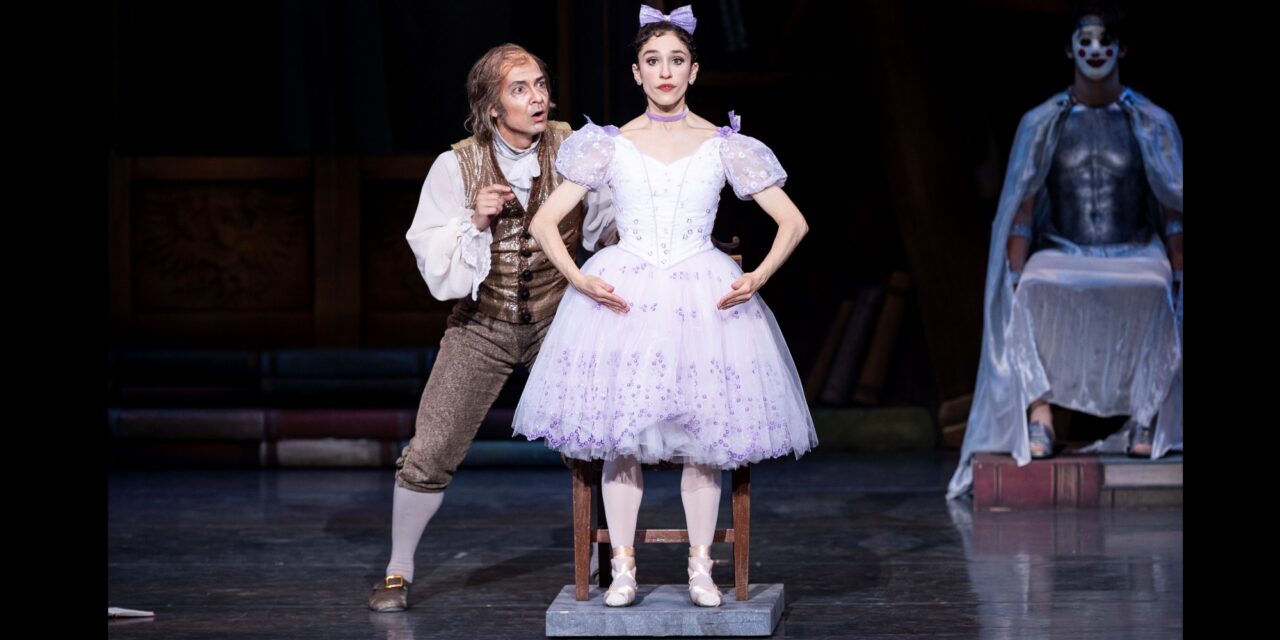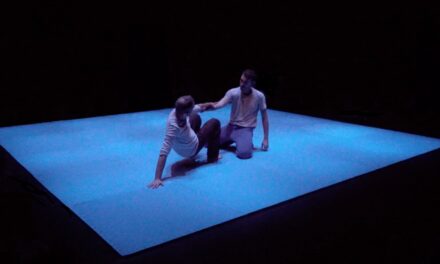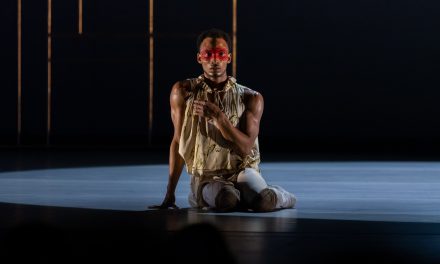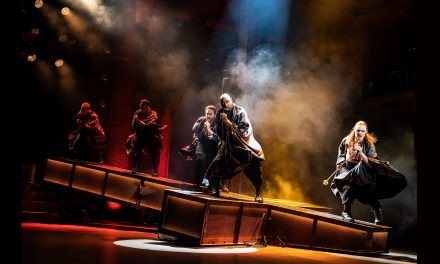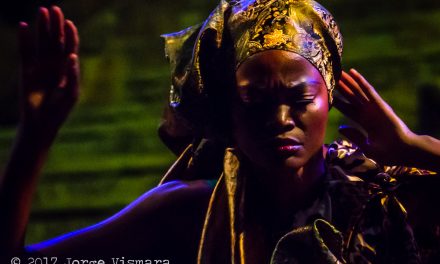“Coppélia” was first performed in 1870 with choreography by Arthur Saint-Leon, then again in the late 19th century with renewed choreography by Marius Petipa. George Balanchine with Alexandra Danilova, put his touch to it in 1974 and this is the version Pacific Northwest Ballet brought to the stage and to streaming this past week. This is a slight story told in fairy tale fashion with just enough plot to lend itself to a ballet. With a lilting score by Leo Delibes this is a delightful show for the whole family.
Synopsis:
Swanhilda a charming and lively Leta Biasucci is engaged to Franz a perfectly cast James Kirby Rogers, who has been enchanted by a beautiful girl reading on the balcony of Dr. Coppelius’s house. Franz sneaks into Coppelius’ workshop where he is caught by the Dr. who wishes to infuse Franz’s spirit into Coppélia a mechanical doll. Swanhilda comes to his rescue by dressing as the doll and coming to life, thus saving Franz from an untimely end.
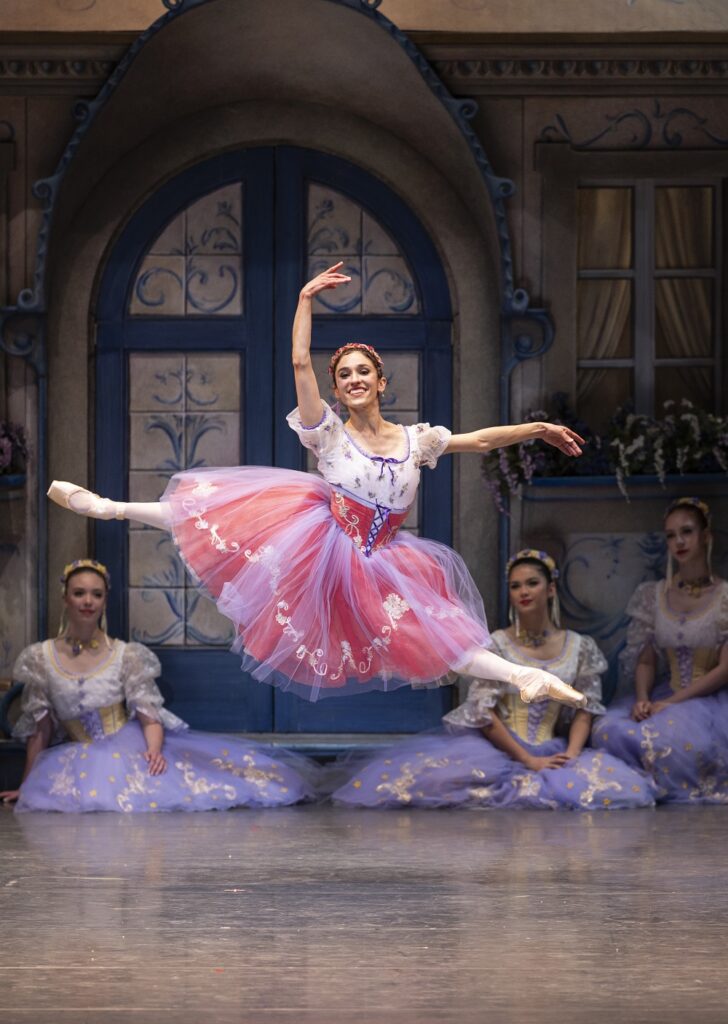
Pacific Northwest Ballet principal dancer Leta Biasucci as Swanilda, in Coppélia, choreographed by Alexandra Danilova and George Balanchine © The George Balanchine Trust – Photo © Angela Sterling.
Act One:
The curtains open to a country fair in the beautiful town square. The set is a stunning rendition of a storybook village with quaint buildings and idyllic surroundings all enhanced by lighting perfection which draws us into a lovely Autum day. Here we are introduced to all the main characters and the village folk. This first act is clean and simple with easy to follow pantomime along with interludes of pleasant peasant dancing. Though set in Galicia the choreography has a distinctly Russian folk feel and given its choreographic history this is understandable. The villagers fill the stage with gaiety and light heartedness in anticipation of the coming celebrations. As day turns to evening, we meet curmudgeonly Dr. Coppelius as he scrambles through the square spreading his ill temper as he goes. Some of the young men Franz included, tease him mercilessly making it clear that Coppelius is the village ogre. Veteran company member James Yoichi Moore plays Coppelius with dark humor as he schemes to bring his automatons to life.
Act Two:
This is by far the strongest and most entertaining of the three acts. Here Swanhilda and her friends sneak into Coppelius’ workshop while he is away. What they discover is a roomful of mechanical dolls including Coppélia the beautiful girl that has enchanted Franz. Charming pantomime and simple dance fills the scene in this strange yet enchanting attic workshop. When Dr. Coppelius returns the girls flee just as Franz scrambles in the window in search of the beautiful balcony girl and just in time to be caught by the strange Dr. With Franz in his clutches Dr. Coppelius gives him a sleeping draught in order to extract his life from him and infuse it into his beloved Coppélia. What he doesn’t know is Swanhilda has switched places and it is she who fools the old Dr. into believing she has indeed come to life. The delightful choreography allows Biascucci to show off her brilliant technique while completely inhabiting the character. Moore is her equal partner here as is Rogers when he comes to realize it is Swanhilda he loves after all.
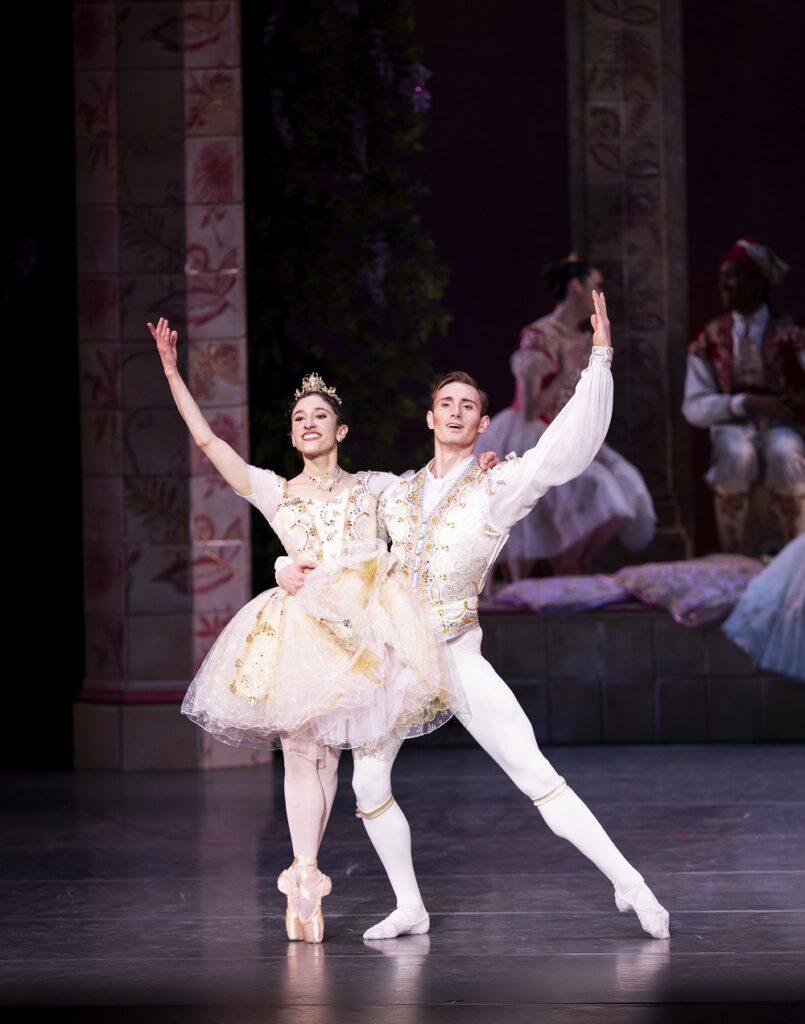
Pacific Northwest Ballet principal dancers Leta Biasucci and James Kirby Rogers in Coppélia, choreographed by Alexandra Danilova and George Balanchine © The George Balanchine Trust – Photo © Angela Sterling.
Act Three:
This is a celebration of the Festival of Bells and a day of weddings including that of Swanhilda and Franz. Just as you might expect it is also reason for a lot of celebratory dancing as group after group parade across the stage always with appropriate choreography, eleven sections in all inexplicably including “Discord and War.” All this could be too long and verge on the redundant if Balanchine had not had the idea to fill the stage with his young female students. These adorable little girls dance with poise and deep commitment in their fairy pink costumes. Finally, there is the marriage of Swanhilda and Franz which allows the pair to dance together again with the effortless ease of dancers at the top of their game. So, though too long the final Act bring a sense of togetherness and joy that only an old chestnut such as this could bring to fruition.
The choreography and staging by Balanchine with Danilova is always exactly right, flowing easily from one segment to the next. The many Costume Designs by Roberta Guidi di Bagno are truly magnificent throughout with no detail left unattended. Transporting you into storybook land are the three impeccable Set Designs also by Roberta Guidi di Bagno. The painterly Lighting Design by Randall G. Chiarelli could not be better as it brings emotional heft to the story. Finally, the live PNB Orchestra conducted by Emile de Cou is again exceptional bringing energy and life to the stage as only live music can do.
Once again, I recommend seeing this or any production that PNB brings to the stage. “Coppélia” is the perfect intro to ballet for newcomers and children alike. Sit back and enjoy what PNB has to offer you will be glad you did.
There are too many cast members to name all but credit must be given to Swanhilda’s friends who add humor and warmth to the proceedings. They are, Madison Rayn Abeo, Ashton Edwards, Melisa Guilliams, Amanda Morgan, Juliet Prine, Clara Ruf Maldonado, Yuki Takahashi and Leah Terada.
For more information about Pacific Northwest Ballet, please visit their website.
Written by Tam Warner for LA Dance Chronicle.
Featured image: PNB principal dancers James Yoichi Moore as Dr. Coppelius, and Leta Biasucci as Swanilda – masquerading as the doll Coppélia, in Coppélia, choreographed by Alexandra Danilova and George Balanchine © The George Balanchine Trust – Photo © Angela Sterling.

